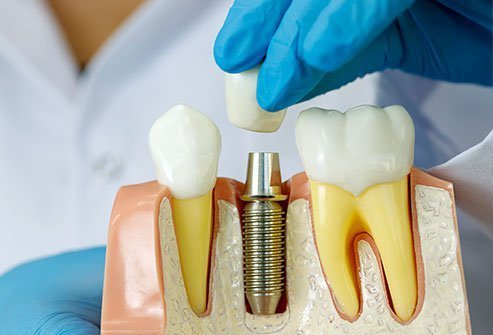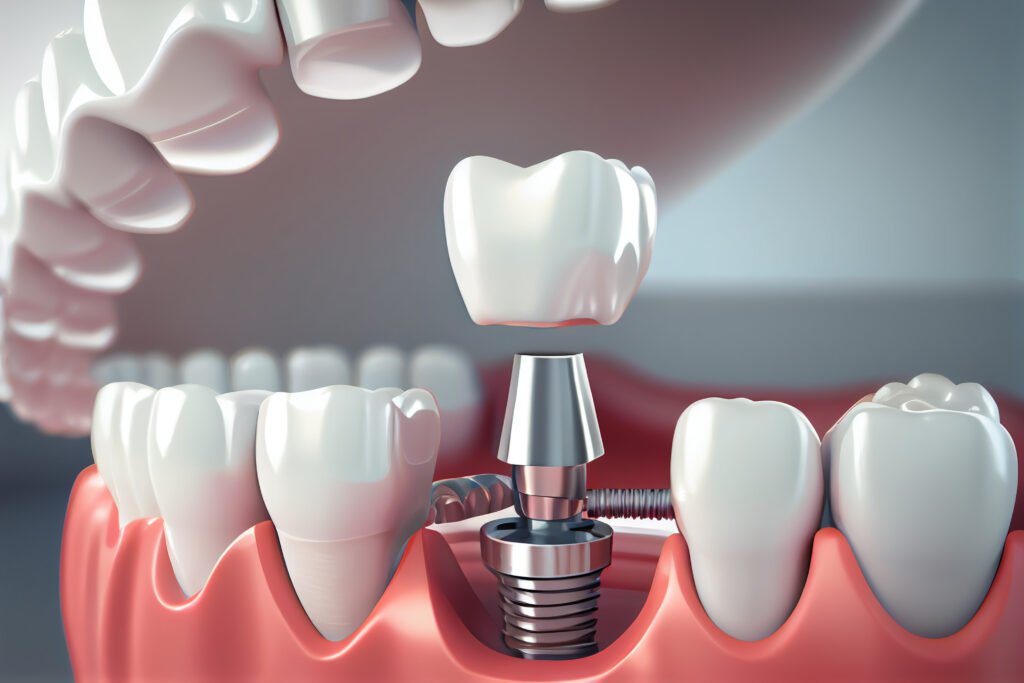
Dental implants are a durable, natural-looking solution for replacing missing teeth. They consist of a titanium post that is surgically placed into the jawbone to act as a secure foundation for crowns, bridges, or dentures, providing the look, feel, and function of natural teeth.
Missing teeth or having problems with dentures or bridges? Dental implants are the solution for you.
These implants are designed to look and feel exactly like natural teeth, helping you replace missing teeth and restore your confident smile. Choosing dental implants is a long-term investment in oral health and offers a better and more permanent solution than other tooth replacement options. However, it is important to note that this advanced technique is expensive.

Dental implants are now seen to be an environmentally friendly choice than bridges or dentures! Dental Implants have a 98% success rate!!
At our clinic, we offer dental implants in Calgary that are both high-quality and cost-effective, allowing you to restore your smile with affordable dental implants. If you’re searching for cheap dental implants without compromising quality, contact us to learn more about our options!
Whether you’re a new patient looking to join our dental family or an existing one with inquiries, feel free to reach out.
Dental implants offer numerous benefits, making them a popular choice for tooth replacement.
1. Avoid bone loss
When you lose your teeth, you also lose bone mass in your jaw. The jaw must be stimulated when the teeth are connected to maintain their mass. The dental implants prevents bone loss.
2. Just like your natural teeth
Dental implants come in many shapes and sizes. You can customise your implant teeth with your dentist according to the required shape, size and colour of your neighbouring teeth. No one but you and your dentist knows which tooth has an implant.
3. Restoration of Bite Force
Dental implants gets fixed in the jaw and titanium posts replace the roots of the teeth, which helps you to bite with the same force as natural teeth. Other tooth replacement options offer limited restoration of bite strength because they rest on the gums and are not anchored in place.
4. Prevents changes in face shape
Teeth help support the facial structure. Teeth fall out, lose support, the shape of your face changes, and you age. Dental implants provide the same support to the face as natural teeth, preventing them from changing shape.
5. Enabling Real Speech
Some dental replacement options, such as dentures, can affect your ability to pronounce words correctly. Missing teeth can also change the story. Implants allow you to speak easily and clearly because they look and function like natural teeth.
6. No holes are created
Although dentures should be worn regularly to prevent bacteria from building up in the mouth and causing infections, dental implant materials are not biodegradable. You will never have to worry about implant holes! Dental implants do not require you to buy special products to clean or maintain them. No cups, pads, glue or special floss needed.
7. No fear of slipping
Dentures can move or slip around in the mouth, patients who wear dentures sometimes feel uncomfortable talking or smiling and eating in public. Dental implants are placed properly which make you feel comfortable and confident.
8. Supports adjacent teeth
If there is a gap in the mouth due to a missing tooth, the teeth on one side of the gap can become misaligned. Dental implants fill those gaps, allowing you to maintain a straight, even smile.
9. A permanent solution to tooth loss
Dental implants are designed to last a lifetime.You just need to maintain oral hygiene.
Safe to say, implants are better, easier, more reliable, and pain-free than dentures and other tooth replacements.

Aches and pains may appear after the implant procedure. Pain medications are used to treat these side effects. Also, you may need night care to protect your new tooth.
It is important to take good care of your new dental implant after surgery. Simply put, we treat you like your natural teeth!
These include:
At our Calgary dental clinic, we offer affordable dental implant solutions to restore your smile comfortably and affordably.
Dental implants are an excellent solution if you have lost teeth due to decay, trauma, tooth decay or oral disease.
Our Calgary dentists at Heritage Hill Dental Clinic consider certain points when evaluating potential candidates for dental implants.
First step is to visit your Dentist and discuss your problem and available solutions. During this first time, the mouth and teeth will be carefully examined, followed by information about the procedure.
The shortest time for a single implant procedure is 5 months for the lower jaw and 6 months for the upper jaw.
In some cases, you may perform a one-part procedure in which your dentist places the implant, the abutment (the connecting structure that securely connects the crown to the implant post), and the crown at the same time. The good news is that dental implants do not require your neighbouring healthy teeth. You will receive a local anaesthetic during the procedure to reduce pain.
Common dental implant procedures include: You will receive local anaesthesia during each procedure to reduce pain.
This process consists of seven steps, including:
7. Follow-up (monitoring).
The dentist will make an incision in the gums where the implant will attach. Next, they drill a hole in the bone for the implant to rest before sewing up the incision. As the jawbone heals, it grows around the implant. This helps secure the replacement tooth. Typically, the healing process ranges from three to six months.
The dentist will create a second incision when the jaw has healed and the implant is firmly in position. The new replacement tooth is then secured in place and the surrounding gum tissue is given time to recover thanks to the installation of an abutment over the implant. To construct a tooth that is exactly like your current dentition, the dentist can also take imprints of your teeth. Lastly, the abutments are used to fasten the crown, or substitute tooth.
Explore our FAQ section to find quick solutions to the most commonly asked questions by our community. Save time and get the answers you need right away
The cost of dental implants doesn’t necessarily depend on how many teeth are missing, but on the number of implants needed to support single or multi-tooth restorations.
For instance, maybe you need to replace all of your upper teeth at one time. Our Calgary implant dentist might recommend four implants placed in strategic points of your arch, and then a full-arch prosthesis such as a hybrid denture (extended bridge) on top of them.
In another situation, you might have 3-4 missing teeth in a row but want to avoid wearing a partial denture. Getting implants would be more expensive initially, but since they last for so long, they offer the best return on investment. And you wouldn’t need an implant for each tooth that’s missing. Rather, we would just install an implant at each end of the space and then affix a multi-tooth dental bridge on top of them.
Knowing how many dental implants you need in total, added to the cost of the fixed prosthesis, plus any adjunctive services (such as bone grafts or X-rays) will determine the full price of treatment.
Since the cost varies greatly from person to person, a consultation is necessary.
Surprisingly to most people, getting dental implants is more comfortable than they ever realized. Since the bone in your mouth where the implant is installed doesn’t have pain receptors, you’ll only feel some minor irritation at the site of the opening in your gums. Fortunately, this heals quite quickly! Most people say that getting dental implants is easier and more comfortable than having a tooth pulled.
Dental implant placement is a type of minor oral surgery, but it’s minimally invasive enough that all our dentist needs to do is apply a small amount of local anesthetic. Once the placement site is thoroughly numbed, we can make a small incision in your gums and install the implant directly into the bone.
If you’re still nervous about getting implants – even as easy as they are – you can request sedation dentistry to help you relax even more! Sedatives ease your anxiety level so that you’ll feel relaxed. As an added bonus, we’ll be able to work more efficiently. Ask if sedation is right for you!
Absolutely, dental implants are safe! There are several advantages to dental implants that make them the best solution for missing tooth replacement:
1.First, implants trigger a process called “osseointegration” which is where a new layer of bone forms around them and fuses the implant permanently into place. This process makes implants predictable and is beneficial to your future oral health. With healthier bone you can reduce shrinkage in areas of tooth loss, further supporting a youthful facial profile.
2.Second, implants are made of biocompatible materials. So, there isn’t a significant chance of any type of allergic reaction or failure after the procedure is completed. In addition to titanium, implants are also available in ceramic.
3.Thirdly, implants are stronger than healthy teeth. It’s possible for our Calgary implant dentist to use pairs of implants to support multi-tooth restorations.
4.Finally, implants are non-invasive to your adjacent teeth. When they’re installed, they don’t require reshaping the neighbouring teeth to help reinforce your implant restoration. Rather, the new implant helps maintain the natural tooth positioning and avoids any negative impact on healthy teeth on either side.
The metal that is used in most dental implants is titanium. Titanium is a hypoallergenic material and extremely friendly to the body. It was first discovered several decades ago and has since been used in medical procedures such as joint replacement with tremendous success.
But even though titanium is naturally accepted by the body, there are even bigger benefits of using it inside of the mouth. For one, it’s stronger than the natural tooth structure. So, when our Calgary implant dentist needs to replace several teeth at one time, we can use pairs or sets of implants to support multi-tooth restorations in lieu of installing an implant at the site of every missing tooth.
The other advantage of using titanium is that it triggers osseointegration within the bone, so when your bone cells come into contact with it, they’re stimulated to generate new bone cells. The bone cells then build a connection between your jaw and the implant surface. When full osseointegration occurs, it’s highly unlikely that your dental implant will ever come out.
From the initial consultation appointment to your final restoration placement, it may be anywhere from 6-12 months in total. However, dental implant installation is a complex process with several different considerations to keep in mind. The actual dental implant installation itself usually only requires one appointment to complete. In most cases, the procedure takes under an hour from start to finish. This phase of the implant procedure is just the placement of the implant “root” that sets down into the bone.
However, your new implant needs time to integrate with the bone before it’s strong enough to support a fixed restoration. This could be anywhere from 3-6 months after the initial placement appointment. In the meantime, you’ll probably wear something called a “healing abutment” or a temporary restoration in that area, so that it doesn’t appear as if you have a missing tooth.
Once fully integrated, we’ll fit you with a special abutment on top of the implant and then take an impression for a permanent crown/bridge/denture, which is usually delivered within the next few weeks.
It depends on the extent of bone loss and the location of the implant. In some cases, we can perform bone augmentation, where grafting is used to build up the area and add a better foundation for future implants to be installed. In other instances, 3D imaging can be used to digitally place the implant at various angles or positions to determine what alternatives are available.
When we’re dealing with a smaller area such as a lower front tooth, there are alternatives like mini dental implants which might be worth considering. However, mini implants aren’t designed for heavy load-bearing areas because of their smaller size.
Fortunately, dental implant treatments are quite a predictable process. With the right resources and imaging techniques, we can make implant therapy a viable option for more people than ever before.
If you’ve been told in the past that dental implants aren’t an option for you because of bone loss, it’s worth getting a second opinion with our Calgary dentist! Newer technology and resources may have changed the scenario for your smile.
You might be surprised to learn that you don’t necessarily need an implant for each missing tooth. If you need to replace all of your upper teeth, for instance, it might be possible to use as few as four implants total. Or if you only need a few replaced, we might anchor a bridge on top of two implants.
However, if you have individual teeth that need to be replaced but they’re located between two healthy teeth, you will need an independent implant and crown in each of those locations. So, in theory, you could have more than four implants in your upper or lower arch.
Visiting with our implant dentist in Calgary will give you an opportunity to learn more about the options that are available for your unique circumstances. From there, we can weigh various scenarios to determine the best solution for your oral health. You’ll get the chance to play a key role in co-planning the next steps for restoring your smile. Chances are, you’ll have more choices than you realized.
While the dental implants procedure is typically safe, there is some degree of risk involved. These risks can include:
Infection or delayed healing at the implant site. Coming in for regular appointments and checkups allows the dentist to monitor the tissue healing.
Injury to the gum tissues or blood vessels around the surgery site. Our dentist will take scans to map out the location of the vessels and take precautions to avoid them.
Damage to the nerves because of which you may sense numbness, tingling, or pain. This discomfort may extend to the tongue, lips, chin, and original teeth. The pre-procedure scans will help our dentist avoid the nerves.
Possibility of an injury to the sinus cavities in case the implant rod sticks through the upper jaw. This is rare!
There aren’t necessarily different types of dental implants, but they can be used to support a variety of dental solutions depending on your unique issues. Dental implants can be used to replace a single tooth or several teeth with an implant-retained bridge or partial denture. Implants can even be used to replace all of your teeth by retaining an entire denture.
Whether you’re a new patient looking to join our dental family or an existing one with inquiries, feel free to reach out.